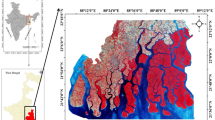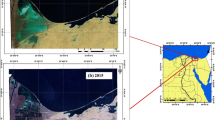Abstract
As human activities influence land cover changes, the environment on human life such as water quality, has been impacted. In particular, huge constructions or reclamation projects are responsible for dramatic land cover changes. The Saemangeum area in South Korea has been one of the largest reclamation projects to progress nearly in two decades. In this study, Landsat-5 Thematic Mapper and Landsat-7 Enhanced Thematic Mapper Plus images were used to classify land cover types in the Saemangeum area. A change detection method was utilized to determine the impacts of the reclamation project. While wetland, grassland, and urban areas were increased, forest, water, and agricultural areas were decreased during the reclamation progress. Water quality analysis related to the land cover changes was conducted to determine the influence of reclamation construction on the environment. Chemical oxygen demand and suspended sediment variability were significantly impacted by the sea current changes after the dyke construction. On the contrary, water temperature and dissolved oxygen were affected by the seasonal influences rather than the reclamation construction. Total nitrogen and total phosphorus were influenced by the fertilizers and pesticides as a result of agricultural activity. The trends of suspended sediment from Landsat images were similar with those from the ground observation sites and also impacted by the dyke construction.







Similar content being viewed by others
References
Ahearn, D. S., Sheibley, R. W., Dahlgren, R. A., Anderson, M., Johnson, J., & Tate, K. W. (2005). Land use and land cover influence on water quality in the last free-flowing river draining the western Sierra Nevada, California. Journal of Hydrology, 313, 234–247.
Anderson, J.R., Hardy, E.E., Roach, J.T., & Witmer, W.E. (1976). A land use and land cover classification system for use with remote sensing data. U.S. Geol. Survey Prop. Pap. 964; U.S. Gov. Print. Office: Washington DC
Bakr, N., Weindorf, D. C., Bahnassy, M. H., Marei, S. M., & El-Badawi, M. M. (2010). Monitoring land cover changes in a newly reclaimed area of Egypt using multi-temporal Landsat data. Applied Geography, 30, 592–605.
Bedard, F., Reichert, G., Dobbins, R., & Trepanier, I. (2008). Evaluation of segment-based gap-filled Landsat ETM+ SLC-off satellite data for land cover classification in southern Saskatchewan, Canada. International Journal of Remote Sensing, 29, 2041–2054.
Chang, H. (2008). Spatial analysis of water quality trends in the Han River basin, South Korea. Water Research, 42, 3285–3304.
Charbonneau, R., & Kondolf, G. M. (1993). Land use change in California, USA: nonpoint source water quality impacts. Environmental Management, 17, 453–460.
Chase, T. N., Pielke, R. A., Kittel, T. G. F., Nemani, R. R., & Running, S. W. (2000). Simulated impacts of historical land cover changes on global climate in northern winter. Climate Dynamics, 16, 93–105.
Dean, A. M., & Smith, G. M. (2003). An evaluation of per-parcel land cover mapping using maximum likelihood class probabilities. International Journal of Remote Sensing, 24, 2905–2920.
Dewan, A. M., & Yamaguchi, Y. (2009). Using remote sensing and GIS to detect and monitor land use and land cover change in Dhaka Metropolitan of Bangladesh during 1960–2005. Environmental Monitoring and Assessment, 150, 237–249.
Foody, G. M. (2002). Status of land cover classification accuracy assessment. Remote Sensing of Environment, 80, 185–201.
Franczyk, J., & Chang, H. (2009). The effects of climate change and urbanization on the runoff of the Rock Creek basin in the Portland metropolitan area, Oregon, USA. Hydrological Process, 23, 805–815.
Fu, C. (2003). Potential impacts of human-induced land cover change on east Asia monsoon. Global and Planetary Change, 37, 219–229.
Johnson, L. B., Richards, C., Host, G. E., & Arthur, J. W. (1997). Landscape influences on water chemistry in midwestern stream ecosystems. Freshwater Biology, 37, 193–218.
Kaiser, M. F. (2009). Environmental changes, remote sensing, and infrastructure development: the case of Egypt’s East Port Said harbour. Applied Geography, 29, 280–288.
Kang, M. S., Im, S. J., Jang, T. I., Park, S. W., & Kim, S. M. (2007). Detecting areal changes in tidal flats after sea dike construction using Landsat-TM images. Journal of Earth System Science, 116, 561–573.
Kuwari, N. Y. A., & Kaiser, M. F. (2011). Impact of north gas field development on landuse/landcover changes al Al Khore, North Quatar, using remote sensing and GIS. Applied Geography, 30, 1144–1153.
Lee, S., Lie, H. J., Song, K. M., Cho, C. H., & Lim, E. P. (2008). Tidal modification and its effect on sluice-gate outflow after completion of the Saemangeum dike, South Korea. Journal of Oceanography, 64, 763–776.
Lee, H. J., & Ryu, S. O. (2008). Change in topography and surface sediments by the Saemangeum dyke in an estuarine complex, west coast of Korea. Continental Shelf Research, 28, 1177–1189.
Li, X., & Damen, M. C. J. (2010). Coastline change detection with satellite remote sensing for environmental management of the Pearl River Estuary, China. Journal of Marine Systems, 82, S54–S61.
Liao, S.-W., Lai, W.-L., Chen, J.-J., Sheu, J.-Y., & Lee, C.-G. (2006). Water quality during development of pollution from rivers in Tapeng Lagoon, Taiwan. Environmental Monitoring and Assessment, 122, 81–100.
Lie, H.-J., Cho, C.-H., Lee, S., Kim, E.-S., Koo, B. J., & Noh, J. H. (2008). Changes in marine environment by a large coastal development of the Saemangeum reclamation projection in Korea. Ocean and Polar Research, 30, 475–484.
Liu, Z.-J., Weller, D. E., Correll, D. L., & Jordan, T. E. (2000). Effects of land cover and geology on stream chemistry in watersheds of Chesapeake bay. Journal of the American Water Resource Association, 36, 1349–1365.
Lodhi, M. A., Rundquist, D. C., Han, L., & Kuzila, M. S. (1998). Estimation of suspended sediment concentration in water using integrated surface reflectance. Geocarto International, 13, 11–15.
Mas, J. F. (1999). Monitoring land-cover changes: a comparison of change detection techniques. International Journal of Remote Sensing, 20, 139–152.
Masek, J. G., Lindsay, F. E., & Goward, S. N. (2000). Dynamics of urban growth in the Washington DC metropolitan area, 1973–1996, from Landsat observations. International Journal of Remote Sensing, 21, 3473–3486.
Matthews, H. D., Weaver, A. J., Eby, M., & Meissner, K. J. (2003). Radiative forcing of climate by historical land cover change. Geophysical Research Letters, 30, 1055.
Maxwell, S. K., Schmidt, G. L., & Storey, J. C. (2007). A multi-scale segmentation approach to filling gaps in Landsat ETM+ SLC-off images. International Journal of Remote Sensing, 28, 5539–5356.
Mertens, B., & Limbin, E. F. (2000). Land-cover-change trajectories in Southern Cameroon. Annals of the Association of American Geographers, 90, 467–494.
Miller, R. L., & McKee, B. A. (2004). Using MODIS Terra 250m imagery to map concentrations of total suspended matter in coastal waters. Remote Sensing of Environment, 93, 259–266.
Min, J. E., Ryu, J.-H., Lee, S., & Son, S. H. (2012). Monitoring of suspended sediment variation using Landsat and MODIS in the Saemangeum coastal area of Korea. Marine Pollution Bulletin, 64, 382–390.
Mundia, C. N., & Aniya, M. (2006). Dynamics of landuse/cover changes and degradation of Nairobi city, Kenya. Land Degradation and Development, 17, 97–108.
Pitman, A. J., Narisma, G. T., Pielke, R. A., & Holbrook, N. J. (2004). Impact of land cover change on the climate of southwest Western Australia. Journal of Geophysical Research, 109, D18109. doi:10.1029/2003JD004347.
Porrello, S., Tomassetti, P., Manzueto, L., Finoia, M. G., Persia, E., Mercatali, I., & Stipa, P. (2005). The influence of marine cages on the sediment chemistry in the Western Mediterranean Sea. Aquaculture, 249, 145–158.
Ramankutty, N., & Foley, J. A. (1999). Estimating historical changes in global land cover: croplands from 1700 to 1992. Global Biogeochemical Cycles, 13, 997–1027.
Ren, W., Zhong, Y., Meligrana, J., Anderson, B., Watt, W. E., Chen, J., & Leung, H.-L. (2003). Urbanization, land use, and water quality in Shanghai 1947–1996. Environment International, 29, 649–659.
Rodríguez-Guzmán, V., & Gilbes-Santaella, F. (2009). Using MODIS 250m imagery to estimate total suspended sediment in a tropical open bay. International Journal of Systems Applications, Engineering & Development, 1, 36–44.
Rogers, D. I., Moores, N., & Battley, P. F. (2006). Northwards migration of shorebirds through Saemangeum, the Geum estuary and Gomso bay, South Korea in 2006. Stilt, 50, 62–78.
Rutherford, G. N., Bebi, P., Edwards, P. J., & Zimmermann, N. E. (2008). Assessing land-use statistics to model land cover change in a mountainous landscape in the European Alps. Ecological Modelling, 212, 460–471.
Teng, S. P., Chen, Y. K., Cheng, K. S., & Lo, H. C. (2008). Hypothesis-test-based landcover change detection using multi-temporal satellite images—a comparative study. Advances in Space Research, 41, 1744–1754.
Tiwari, K. M., & Saxena, A. (2011). Change detection of land use/Landcover pattern in an around Mandideep and Obedullaganj area, using remote sensing and GIS. International Journal of Technology and Engineering System, 2, 342–350.
Tyler, A. N., Svab, E., Preston, T., Présing, T., & Kovács, W. A. (2006). Remote sensing of the water quality of shallow lakes: a mixture modelling approach to quantifying phytoplankton in water characterized by high-suspended sediment. International Journal of Remote Sensing, 27, 1521–1537.
Wear, D. N., Turner, M. G., & Naiman, R. J. (1998). Land cover along an urban–rural gradient : implications for water quality. Ecological Applications, 8, 619–630.
Weng, Q. (2002). Land use change analysis in the Zhujiang Delta of China using satellite remote sensing, GIS and stochastic modelling. Journal of Environmental Management, 64, 273–284.
Yang, L., Xian, G., Klaver, J. M., & Deal, B. (2003). Urban land-cover change detection through sub-pixel imperviousness mapping using remotely sensed data. Photogrammetric Engineering and Remote Sensing, 69, 1003–1010.
Yuan, F., Sawaya, E. K., Loeffelholz, C. B., & Bauer, E. M. (2005). Land cover classification and change analysis of the Twin Cities (Minnesota) metropolitan area by multitemporal Landsat remote sensing. Remote Sensing of Environment, 98, 317–328.
Acknowledgments
This work was supported by the research fund of Hanyang University (HY-2010-O).
Author information
Authors and Affiliations
Corresponding author
Rights and permissions
About this article
Cite this article
Choi, M., Han, S. Remote sensing imageries for land cover and water quality dynamics on the west coast of Korea. Environ Monit Assess 185, 9111–9124 (2013). https://doi.org/10.1007/s10661-013-3240-1
Received:
Accepted:
Published:
Issue Date:
DOI: https://doi.org/10.1007/s10661-013-3240-1




